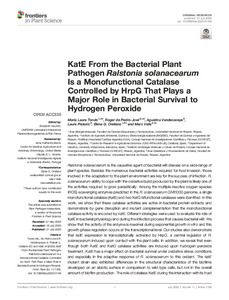Por favor, use este identificador para citar o enlazar este ítem:
https://repositorio.uca.edu.ar/handle/123456789/11602| Título: | KatE from the bacterial plant pathogen Ralstonia solanacearum is a monofunctional catalase controlled by HrpG that plays a major role in bacterial survival to hydrogen peroxide | Autor: | Tondo, María Laura de Pedro Jové, Roger Vandecaveye, Agustina Piskulic, Laura Orellano, Elena G. Valls, Marc |
Palabras clave: | MARCHITEZ; Ralstonia solanacearum; CATALASAS; katE; BACTERIAS | Fecha de publicación: | 2020 | Editorial: | Frontiers | Cita: | Tondo, M.L. et al. KatE from the bacterial plant pathogen Ralstonia solanacearum is a monofunctional catalase controlled by HrpG that plays a major role in bacterial survival to hydrogen peroxide [en línea]. Frontiers in Plant Science. 2020. 11:1156. doi: 10.3389/fpls.2020.01156 Disponible en: https://repositorio.uca.edu.ar/handle/123456789/11602 | Resumen: | Abstract: Ralstonia solanacearum is the causative agent of bacterial wilt disease on a wide range of plant species. Besides the numerous bacterial activities required for host invasion, those involved in the adaptation to the plant environment are key for the success of infection. R. solanacearum ability to cope with the oxidative burst produced by the plant is likely one of the activities required to grow parasitically. Among the multiple reactive oxygen species (ROS)-scavenging enzymes predicted in the R. solanacearum GMI1000 genome, a single monofunctional catalase (KatE) and two KatG bifunctional catalases were identified. In this work, we show that these catalase activities are active in bacterial protein extracts and demonstrate by gene disruption and mutant complementation that the monofunctional catalase activity is encoded by katE. Different strategies were used to evaluate the role of KatE in bacterial physiology and during the infection process that causes bacterial wilt. We show that the activity of the enzyme is maximal during exponential growth in vitro and this growth-phase regulation occurs at the transcriptional level. Our studies also demonstrate that katE expression is transcriptionally activated by HrpG, a central regulator of R. solanacearum induced upon contact with the plant cells. In addition, we reveal that even though both KatE and KatG catalase activities are induced upon hydrogen peroxide treatment, KatE has a major effect on bacterial survival under oxidative stress conditions and especially in the adaptive response of R. solanacearum to this oxidant. The katE mutant strain also exhibited differences in the structural characteristics of the biofilms developed on an abiotic surface in comparison to wild-type cells, but not in the overall amount of biofilm production. The role of catalase KatE during the interaction with its host plant tomato is also studied, revealing that disruption of this gene has no effect on R. solanacearum virulence or bacterial growth in leave tissues, which suggests a minor role for this catalase in bacterial fitness in planta. Our work provides the first characterization of the R. solanacearum catalases and identifies KatE as a bona fide monofunctional catalase with an important role in bacterial protection against oxidative stress. | URI: | https://repositorio.uca.edu.ar/handle/123456789/11602 | ISSN: | 1664-462X | Disciplina: | INGENIERIA AMBIENTAL | DOI: | 10.3389/fpls.2020.01156 | Derechos: | Acceso abierto | Fuente: | Frontiers in Plant Science. 2020. 11:1156 |
| Aparece en las colecciones: | Artículos |
Ficheros en este ítem:
| Fichero | Descripción | Tamaño | Formato | |
|---|---|---|---|---|
| kate-bacterial-plant-pathogen.pdf | 1,39 MB | Adobe PDF |  Visualizar/Abrir |
Visualizaciones de página(s)
91
comprobado en 30-abr-2024
Descarga(s)
88
comprobado en 30-abr-2024
Google ScholarTM
Ver en Google Scholar
Altmetric
Altmetric
Este ítem está sujeto a una Licencia Creative Commons

